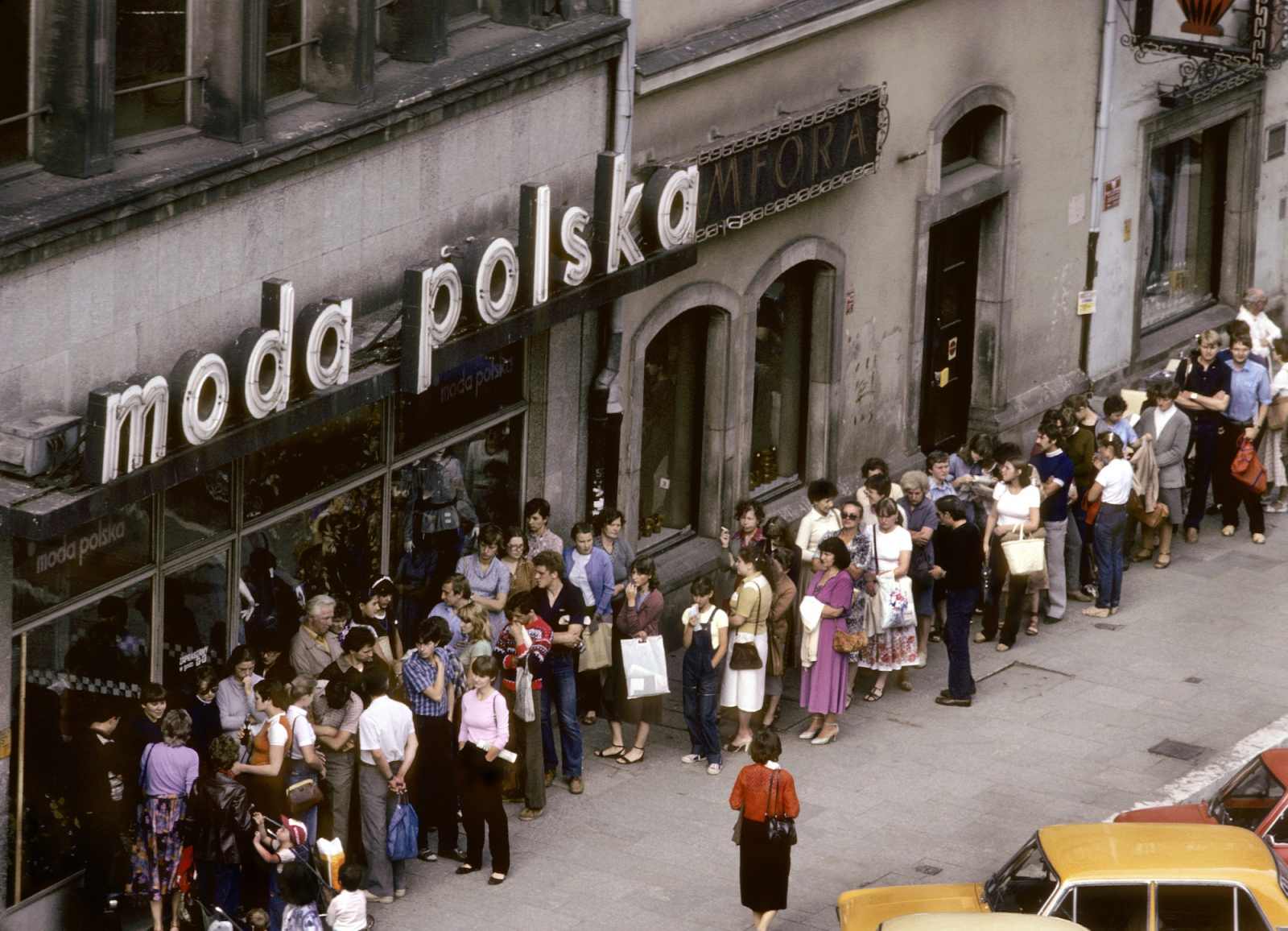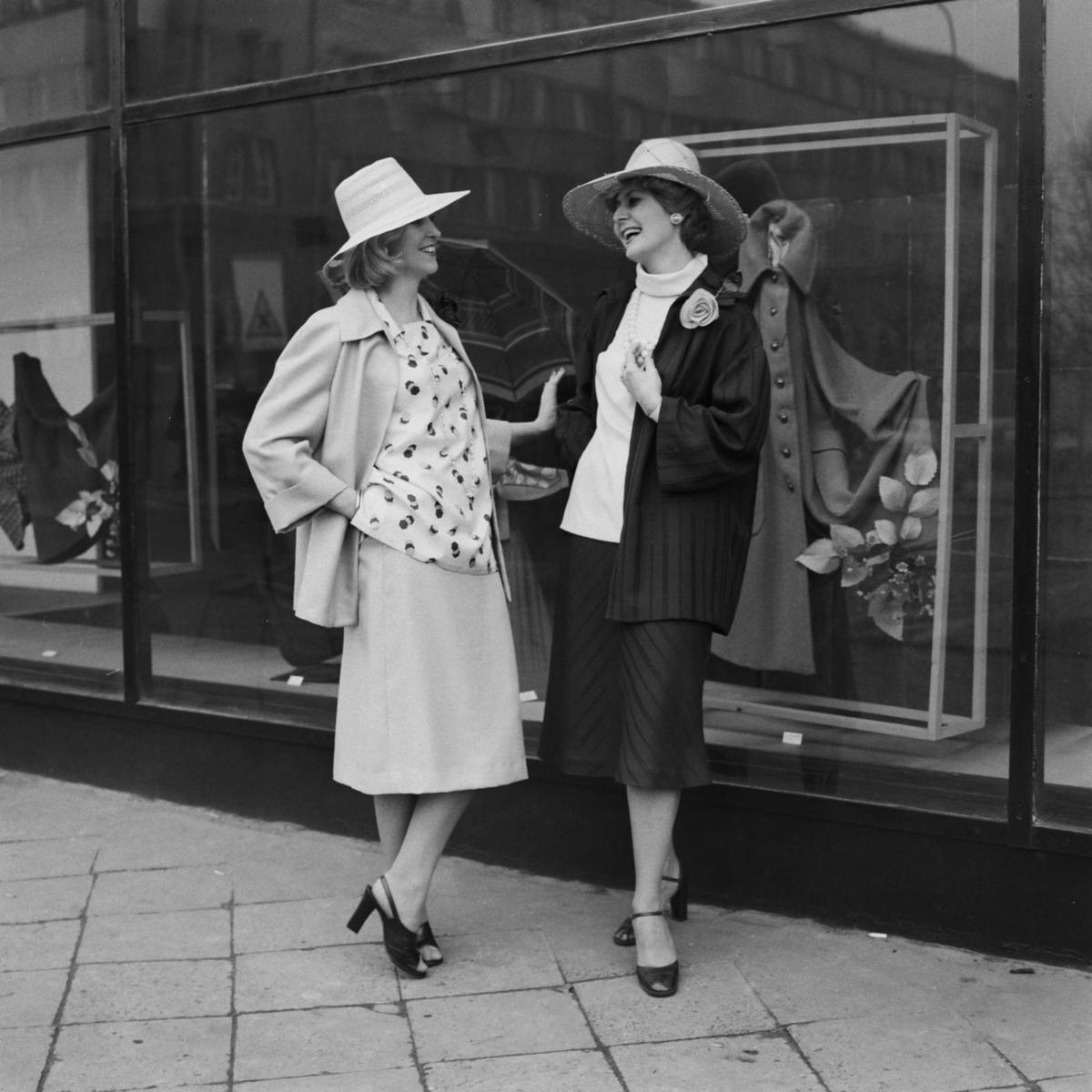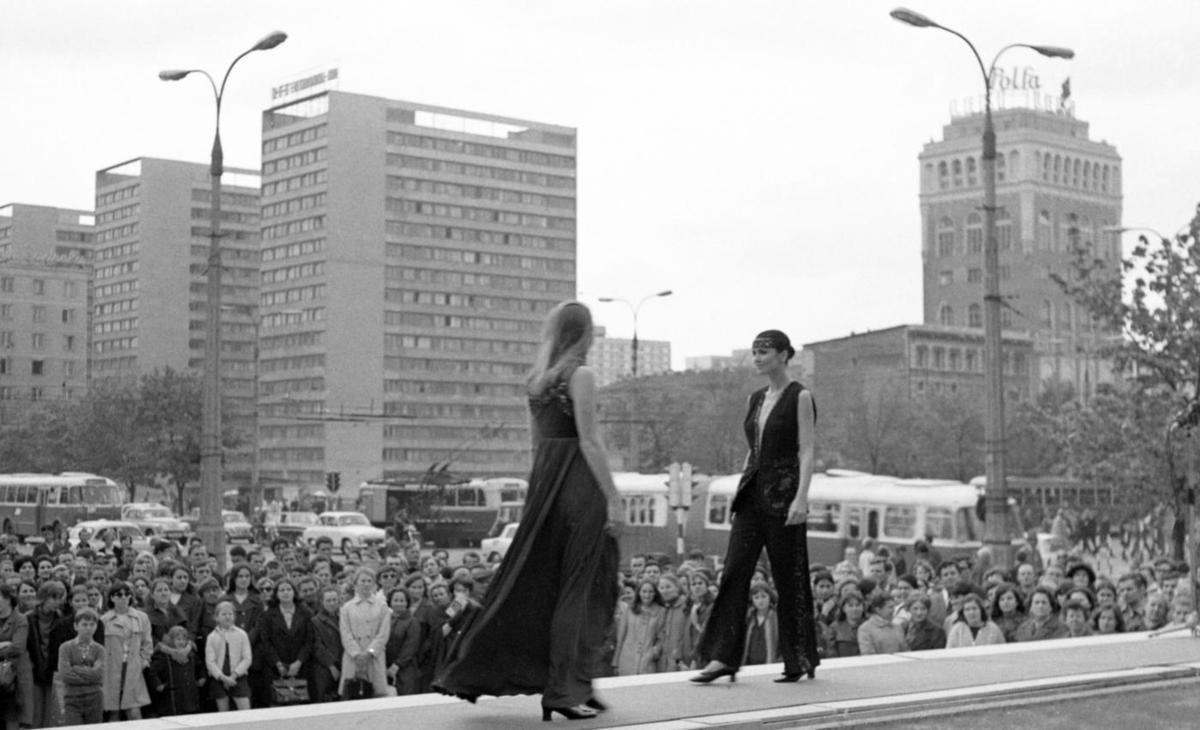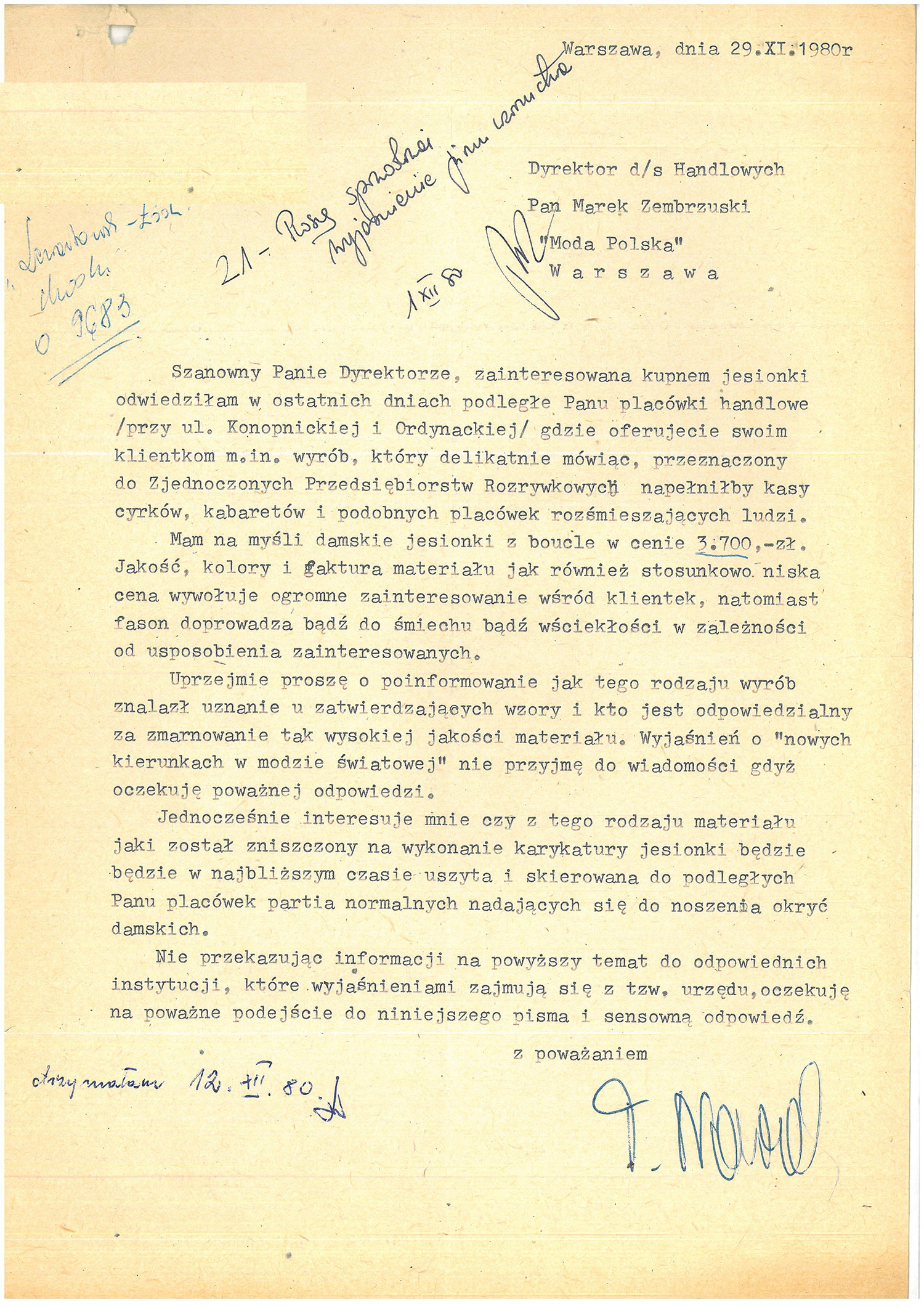
Moda Polska wzbudzała emocje, zanim jeszcze powstała. Bo zapowiadała się luksusowo. A z luksusem wiadomo, jak jest. Wszyscy niby wyśmiewają, ale chętnie by doświadczyli. Konfrontujemy legendę Mody Polskiej z tym, co naprawdę myśleli o niej klienci.
Jedno jest pewne. Mody Polskiej nie ma od dwudziestu lat, a markę ma tak silną, że mogłyby jej pozazdrościć te współcześnie istniejące. Gdy Ewa Rzechorzek zbierała materiały do książki „Moda Polska Warszawa”, wielokrotnie spotykała ludzi, którzy przekonywali ją, że mają ubranie kupione w Modzie. Dopiero potem okazywało się, że zgadza się adres, ale nie marka. Ta zakorzeniła się w miastach tak bardzo, że jeśli dziś w jej dawnym salonie działa inny sklep, wciąż mówi się, że to „Moda Polska”. Nawet jeśli żaden już nie działa, ludzie pamiętają, gdzie był. Bo Moda Polska, choć nie ubierała mas, wrosła w masową wyobraźnię.

Szarpanie za klamkę
Zamysł był zresztą taki, że bardziej niż ubierać, ma edukować. Branżę w sprawie aktualnych trendów, a społeczeństwo w kwestii dobrego smaku. Pierwsza szefowa artystyczna Mody Polskiej, Jadwiga Grabowska pytana przez dziennikarzy, gdzie można kupić rzeczy z pokazów, odpowiadała: – Nigdzie, to dydaktyka. Już w Salonie Mody Ewa, którym kierowała wcześniej, ceny były zaporowe. Właściwie poniżej żon dyplomatów nikt tam nie kupował. Prasa popularna kpiła i nawoływała do rozsądku, prasa bardziej elegancka ochoczo publikowała zdjęcia z rewii mody w Ewie. I pół Warszawy zabijało się o zaproszenia na te rewie.
Krótko mówiąc, Moda Polska wzbudzała emocje, jeszcze zanim powstała. Bo, jeszcze będąc Ewą, zapowiadała się luksusowo. A z luksusem, niezależnie od czasów, w których przychodzi mu być, wiadomo jak jest. Wszyscy wyśmiewają, ale chętnie doświadczyliby. Początkowo była tylko w Warszawie, ale prędko otwarto salony w Katowicach i w Gdyni, bo tam w PRL-u mieszkało najwięcej zamożnych ludzi. Poważna ekspansja na kraj zaczęła się w połowie lat 70., gdy w wyniku reformy samorządowej powstało 49 województw. Każde miasto wojewódzkie chciało więc mieć u siebie sklep Mody Polskiej. Otwierano, zazwyczaj we wzniosłej atmosferze. W 1978 roku w Bydgoszczy, trzydziesty w kraju. Na uroczystość przybył wicewojewoda, wiceprezydent miasta, dyrektorzy związanych z handlem instytucji, komendant milicji i dziennikarze. Wśród nich reporterka Barbara Łopieńska. Pisała: „Taki salon jest ambicją każdego miasta. Walczy Gorzów, Piła, Przemyśl. Walczy Konin i Radom, a pani prezydent Jeleniej Góry tak się uparła, że oddaje najlepszy lokal na Starym Mieście. Wszystkie miasta walczą, żeby mieć salon „Mody Polskiej”. (…) Zaproszeni goście są już w środku.
– Pozwólcie, że podziękuję Modzie Polskiej – mówi wiceprezydent. – Jest to dla nas bardzo ważny moment, bo społeczeństwo Bydgoszczy odczuwa braki w zaopatrzeniu – i rusza z nożyczkami na wstęgę.
Pani Krysia z męskich kosmetyków trzęsącymi rękami układa sobie kalki. Chyba weźmie jeszcze jedno relanium.
- Za chwilę – mówi – wypiszę pierwszy w życiu paragon.
- Są koszule typu safari? – pytają dygnitarze. – Nie ma? A zbliżone? Z pagonami, z kieszonkami?
Pani dyrektor Wanda Gajewska [zastępczyni dyrektora Mody Polskiej do spraw handlowych – przyp. AB] oprowadza wiceprezydenta.
– A to jest – mówi – torba. No, cztery tysiące pięćset – rzeczywiście wydatek. Ale w Warszawie już tych toreb nie ma.
– Już poszły? – nie daje wiary wiceprezydent. – No, zresztą u nas w stosunku do zagranicy ceny są rewelacyjnie niskie”.
O cenach jest w tekście więcej. Paski za 980 zł szły lepiej niż tańsze po 220 zł. Męskie koszule po 1700 zł poszły, zanim przyszły. Mówiło się, że będą botki z wężowej skóry po dwadzieścia cztery tysiące. Ale to plotka, z wężowej skóry były jedynie torebki – trzysta na cały kraj – raptem po pięć tysięcy dwieście. Przeciętna pensja wówczas wynosiła cztery osiemset z hakiem. A jednak ludzie – zwyczajni bydgoszczanie, nie żadni dygnitarze, dzwonili pytać, kiedy otwarcie sklepu. Kierownik nie informował, „żeby – jak mówi – nie było stratowania”. I tak przyszli pod salon. Pobyć w gęstniejącym tłumie i od czasu do czasu szarpnąć za klamkę.
Dyrektorowe i aptekarzowe
A potem przyjść do czynnego już salonu, rozejrzeć się i wpisać do księgi życzeń i zażaleń na przykład taki wniosek: „Wobec przerażających cen, które są niedostępne dla ludzi pracy wszystkich zawodów, weteranów pracy, proponuję wywiesić zawiadomienie: Wstęp tylko dla bogaczy”. Za ceny dostawało się Modzie od wszystkich. Mówiło się, że to sklepy dla dyrektorowych i badylarzowych.
Hanna Krall, zanim została Hanną Krall, którą znamy, była dziennikarką „Polityki”, która specjalizowała się w dokuczaniu dyrektorom. Chodziła do Orbisu, chodziła do Horteksu, zaczepiała szefów Domów Towarowych Centrum. Na Modę Polską trafiło w lecie 1975 roku. Spotkała się z ówczesnym dyrektorem Stanisławem Tusińskim i jego zastępczynią ds. mody, Haliną Kłobukowską.

„– Panie dyrektorze, jeszcze mi się nie zdarzyło cokolwiek kupić u was. Takie to dostojnie dystyngowane wszystko, takie – jak mówi moja koleżanka – w stylu pani aptekarzowej, która chce się pokazać. No i te ceny… TE CENY!!! Dla kogo wy właściwie jesteście?” – już pierwsze pytanie ustawiło rozmowę. Stanisław Tusiński tłumaczył, że Moda Polska nie reprezentuje mody „na pańcię”, a przeciwnie, zawzięcie ją tępi. „Jesteśmy dla tych, którzy pragną zaspokoić swoje estetyczne i snobistyczne aspiracje kupując atrakcyjny towar” – mówił i dowodził, że wraz ze wzrostem dobrobytu poszerza się krąg klientek, ostatnio na przykład w Płocku przybyły żony inżynierów z Petrochemii.
Halina Kłobukowska przyznawała, że – owszem – są zamożne klientki, które ubierają się w Modzie od stóp do głów, ale przybywa takich, które czasem kupują coś eleganckiego. „Młode kobiety kończące studia kupują sobie przed podjęciem pierwszej pracy jakąś jedną elegancką rzecz – zwłaszcza kiedy panowała moda na niedbałość. Takie młode lekarki czy inżynierowie nie mogły sobie pozwolić na niedbały styl – co by sobie o nich pomyśleli ich zwierzchnicy i podwładni? Same mi się zwierzały z tego i sama nieraz im doradzałam suknię, w której widać od razu, że ma się w głowie fabrykę, pracę i w ogóle sprawy poważne. Kupują także u nas starsze panie mające wkrótce przejść na emeryturę. Sprawiają sobie jakby drugą wyprawę – kilka praktycznych rzeczy, w których nie będzie to już później uboga babcia w rodzinie, to będzie wytworna starsza pani. Dość często przychodzą panie w trudnej sytuacji życiowej – na przykład po rozwodzie. Mówią – nic tak dobrze nie robi na samopoczucie, jak nowa suknia. Coraz częściej panny młode przyprowadzane przez mamy i ciocie zamawiają sobie suknie ślubne. Ciocie mówią: - Jak zapyta ktoś na przyjęciu, skąd taka piękna suknia i jak odpowiemy, że z Mody Polskiej, to zrobi to naprawdę wrażenie”.
A ceny? Zdaniem dyrekcji ten zarzut to czepialstwo. Bo po pierwsze, nie wszystkie były wygórowane, a po drugie, najdroższe rzeczy sprzedawały się najlepiej. Kolekcje karnawałowe, w tym suknie za siedem tysięcy, schodziły na pniu.
Bistorek byłby w porządku
Narzekano też, jakże by inaczej, na fasony. W archiwum Jerzego Antkowiaka zachował się list, który rozżalona klientka napisała w 1980 roku: „Szanowny Panie Dyrektorze, zainteresowana kupnem jesionki odwiedziłam w ostatnich dniach podległe Panu placówki handlowe, gdzie oferujecie swoim klientkom m.in. wyrób, który delikatnie mówiąc, przeznaczony do Zjednoczonych Przedsiębiorstw Rozrywkowych napełniłby kasy cyrków, kabaretów i podobnych placówek rozśmieszających ludzi. Mam na myśli damskie jesionki z bouclé w cenie 3.700 zł. (…) Fason doprowadza bądź do śmiechu bądź wściekłości w zależności od usposobienia zainteresowanych. Uprzejmie proszę o poinformowanie, jak tego rodzaju wyrób znalazł uznanie u zatwierdzających wzory i kto jest odpowiedzialny za zmarnowanie tak wysokiej jakości materiału. Wyjaśnień o „nowych kierunkach w modzie światowej” nie przyjmę do wiadomości, gdyż oczekuję poważnej odpowiedzi.”
Pani Teresa z Warszawy, zapewne nieświadomie, trafiła w sedno konfliktu, który przez całe lata trapił Modę Polską. Rozgrywał się na linii projektanci – handlowcy. Obrazowo ujęła to projektantka Magda Ignar: „Mówimy o dziedzinie, która wymaga ryzyka. Popyt trzeba wyprzedzać. Półki powinny nie tylko uginać się od dobrych towarów, ale uginać się w porę”.
Otóż, jak wynika ze wspomnień projektantów, handlowcy, a w szczególności kierownicy salonów w kraju, nie akceptowali pomysłów centrali. W PRL-u droga ubrania od projektu do sklepu zajmowała mniej więcej półtora roku, i była bardzo wyboista. W Modzie Polskiej było nieco łatwiej niż gdzie indziej, ale kolekcje handlowe, czyli te przeznaczone do sklepów, a nie na wybieg, musiały zostać zaakceptowane przez branżowe komisje. Ostateczna decyzja o tym, co będzie sprzedawane, należała do kierowników salonów. Oglądali propozycje projektantów i wybierali z nich to, co chcieli. Nie kryli przy tym, że mają projektantów za niewydarzonych artystów, którzy nie mają pojęcia o tym, czego potrzebują ludzie. Projektanci handlowcom zarzucali tchórzostwo i asekuranctwo.

Jerzy Antkowiak: „Jakie zdarzały się reakcje? To w naszych salonach?! Taka bawełna, taki drelich drapany! Po moim trupie! Czy nie tak wołał jeden z kierowników? (…) Jakby to był bistorek, to wszystko byłoby w porządku” – niegniotący się bistor był wielkim hitem peerelowskich fabryk, a przy okazji synonimem złego gustu. Gdy w 1978 roku Moda Polska zaproponowała na wiosnę drelichy, wybuchł skandal. W prasie pojawiły się o tym całostronicowe artykuły, kierowniczka od handlu chciała rezygnować z pracy. A jednak tym razem zwyciężyli plastycy, bo sklepy wzięły te ciuchy. Podobno sprzedały się lepiej niż kilka poprzednich kolekcji. Być może dzięki nowemu wówczas w Modzie Polskiej dyrektorowi Józefowi Syroce, który miał dość „kapitanów przemysłu, którzy mają znaczące wpływy, a niedostateczne umiejętności” i, jak wcześniej w Corze, próbował zrobić więcej i lepiej niż pozwalały przepisy i nawyki.
W dobrym tonie: ponarzekać
Drelich nie drelich, drogo czy tanio, przed salonami Mody Polskiej ustawiały się kolejki szarpiących za klamkę, a w nerwach pewnie i za poły marynarki sprzedawcy. Nie dlatego, że wszyscy tak pokochali projekty Jerzego Antkowiaka i jego drużyny, tylko dlatego, że były tam rzeczy z importu. Biustonosze Triumpha, kosmetyki Yardleya, a czasem i Diora, rajstopy, sweterki. Słowem, wybór jak w Peweksie, a za złotówki. Moda Polska handlowała zagranicznymi rzeczami, bo uprzywilejowanie miało swoją cenę. Nie miała fabryki, która uszyłaby jej tyle ubrań, żeby starczyło dla wszystkich salonów. Trzeba było uzupełniać importem. Pod koniec lat siedemdziesiątych stanowił 60 proc. asortymentu. I powodował kłopoty. Bo trafiła się partia beznadziejnie niedobrych hiszpańskich torebek. Niedoróbki w jugosłowiańskich szetlandach. Koszule w fasonie jak trzeba, ale kolorach najmniej oczekiwanych. Pretensji była moc i wszystkie szły na konto Mody Polskiej, bo przecież kupowano je w sklepach opatrzonych jej szyldem. A, jak już wiemy, w dobrym tonie było na Modę Polską ponarzekać.
– Ona zawsze była trochę niewygodna – mówi Ewa Rzechorzek, autorka książki „Moda Polska Warszawa”. – Miała zapewnione specjalne traktowanie władz – pierwszeństwo w dostępie do tkanin, wyjazdy do Paryża, świetnie urządzone salony w bardzo dobrych punktach miast. To musiało wzbudzać zazdrość. Była łatwym celem ataku, często trochę na zasadzie: „nie mogę tego mieć, to chociaż skrytykuję”. Halina Kłobukowska mówiła w 1978 roku – a był to szczytowy czas dla przedsiębiorstwa – że Moda Polska ubiera dwa procent społeczeństwa. Bo społeczeństwo w PRL-u w dużej mierze ubierało się samo. Kobiety szyły, przerabiały, biegały do krawcowych. Moda Polska, jakkolwiek krytykowana, była marzeniem.
– Firma, która ma prawa do znaku towarowego, zamówiła w 2008 roku badania marketingowe. Okazało się, że markę zna 80 proc. respondentów – mówi Ewa Rzechorzek. Sama całkiem niedawno odwiedziła Galerię Wzornictwa Polskiego w warszawskim Muzeum Narodowym. Zatrzymała się przy gablocie z metkami różnych firm, by posłuchać, co mówią zwiedzające. Mówiły o Modzie Polskiej.
5 października w Centralnym Muzeum Włókiennictwa w Łodzi rozpocznie się wystawa poświęcona twórczości Jerzego Antkowiaka i Modzie Polskiej, której kuratorem jest Tomasz Ossoliński. Projektant pracuje też na filmem o Antkowiaku. „Vogue” objął nad przedsięwzięciami patronat.



Zaloguj się, aby zostawić komentarz.